Yes, electric fireplaces can use a considerable amount of electricity, especially when using the heating function. But here's the thing—they're actually more energy-efficient than traditional fireplaces since they don't lose heat up a chimney. Every bit of warmth stays in your room.
So what's the real cost? We'll break down actual energy usage, compare monthly bills, and share smart tips to maximize efficiency while keeping that cozy glow.
Quick Answers: Your Top Questions Answered
- Do they use a lot of electricity? No. An electric fireplace uses about 1,500 watts, similar to a coffee maker or a small space heater. When using only the flame effect, it consumes as little energy as a single light bulb.
- How much does it cost to run per month? On average, if you use the heater for a few hours each day, you can expect your bill to increase by about $30 per month. Using the flame-only effect costs less than a dollar per month.
- Do they actually produce heat? Yes. They are effective supplemental heaters, capable of warming up a standard 400 sq. ft. room, making your space cozy without turning up the central thermostat.
- Are they energy efficient? Absolutely. Nearly 100% of the electricity an electric fireplace consumes is converted directly into heat, meaning almost no energy is wasted.

How Do Electric Fireplaces Work?
Electric fireplaces pull off two impressive tricks: they keep you warm and create that mesmerizing flame effect we all love. Let's dive into how they actually make this magic happen.
How Do Electric Fireplaces Produce Heat?
Today's electric fireplaces use three clever heating methods:
- Heated wire coils: Think of it like a giant hair dryer. Metal coils (typically copper or aluminum) heat up when electricity flows through them, while a built-in fan blows that warmth around your room for quick, even heating.
- Ceramic plates: These units work differently—ceramic plates convert electricity into radiant heat that warms objects directly, not just the air. It's like standing in sunlight on a cold day.
- Infrared technology: The high-tech option. Infrared fireplaces beam heat straight to people and furniture in the room. Take the Hilo TV Stand With Fireplace—it efficiently heats large spaces and lets you control everything with a remote. Pretty sweet.
How Do Electric Fireplaces Produce a Flame Effect?
- LED lights and refraction technology: Most electric fireplaces fake those dancing flames using clever LED setups. Multiple lights shine through specially grooved panels that bend and scatter the light, creating surprisingly realistic flame movements.
- Water vapor systems: The luxury models take it further. They combine water vapor with LED lights to produce flames with real depth and movement—some even puff out fake smoke for that authentic campfire vibe.
Do Electric Fireplaces Use a Lot of Energy?
The answer depends on many factors. Below we analyse in detail the factors that affect the energy consumption of electric fireplaces and compare the energy consumption of electric fireplaces with that of common household appliances to help you understand the energy efficiency of electric fireplaces in actual use:
Factors Affecting the Energy Consumption of Electric Fireplaces
Power and Energy Consumption
Electric fireplaces typically run between 750-1500 watts. High heat means more electricity use. But here's the kicker—flame-only mode drops to just 20-40 watts. That's less than most light bulbs.
Frequency of use
Running it every evening for a few hours? That's way different than 24/7 operation. Weekend use versus daily use can mean hundreds of dollars difference on your annual bill.
Usage Mode
Most units offer multiple settings. Full heat mode warms rooms fast but gulps electricity. Flame-only mode creates ambiance using minimal power—perfect for summer nights when you want the look without the heat.
Installation Location
Interior wall placement beats exterior walls every time. Why? Less heat escapes through insulated interior walls. Near windows or doors? You're basically heating the outdoors.
Smart Control Functions
Modern units include thermostats and timers that prevent energy waste. They automatically reduce power when rooms reach set temperatures and shut off on schedules. No more accidentally leaving it running all night.
Efficiency of the Appliance
Newer models pack better tech. Advanced heating elements and precise controls deliver more heat per watt consumed. Quality matters—cheap units often use more electricity for less warmth.
Energy Consumption of Electric Fireplaces Compared to Household Appliances
Comparison with Large Appliances
Electric fireplaces beat central heating for single rooms—no wasted energy heating empty spaces. They use less power than portable ACs (2000W) or washing machines (2200W), making them relatively efficient for targeted heating.
Comparison with Small Appliances
Power-wise, they're similar to hair dryers or microwaves. But smart features make the difference—automatic adjustments mean they're not constantly running at full blast like basic appliances.
Comparison with Space Heaters
Both pull similar wattage, but electric fireplaces win on efficiency. Smart controls and better heat distribution mean less runtime for the same comfort level. Space heaters just burn electricity nonstop.
How Much Electricity Does an Electric Fireplace Use?
To get an accurate picture of how much electricity an electric fireplace uses, we will explore the specific power consumption of different usage modes to help users estimate and plan energy consumption based on their usage habits.
Most electric fireplaces pull between 1,000-2,000 watts. The sweet spot? 1,500-watt models on standard 120V outlets—they're everywhere for good reason.
Before diving into the numbers, here's what you need to know:
- Watts (W) and Kilowatts (kW): How fast your fireplace uses electricity. Think of it like a car's speed. 1,000 watts = 1 kilowatt.
- Kilowatt Hours (kWh): What actually shows up on your bill. It's like measuring distance traveled. Running a 1,000-watt device for one hour = 1 kWh.
Let's break down a typical 1,500-watt fireplace running 6 hours daily:
Full Power Mode
- Per hour: 1.5 kWh
- Per day: 1.5 kWh × 6 hours = 9 kWh
- Per month: 9 kWh × 30 days = 270 kWh
Flame Mode Only
- Per hour: about 0.3 kWh
- Per day: 0.3 kWh × 6 hours = 1.8 kWh
- Per month: 1.8 kWh × 30 days = 54 kWh
Intermittent Heating Mode
- Adjusted power: about 750W (0.75 kW)
- Per hour: 0.75 kWh
- Per day: 0.75 kWh × 6 hours = 4.5 kWh
- Per month: 4.5 kWh × 30 days = 135 kWh
Reality check: Most people don't run fireplaces constantly. Use it 3 hours instead of 6? Cut these numbers in half. Marathon 12-hour sessions? Double them. Winter-only users see big bills just a few months a year.

How Much Does It Really Cost to Run an Electric Fireplace?
Now, let's translate that electricity usage into dollars and cents. According to data provided by EnergyBot, the average electricity rate in the U.S. is 17.11 cents per kilowatt-hour (as of early 2025). We'll use a slightly rounded-up number for easier calculation.
Here’s a clear breakdown of the estimated running costs for a standard 1,500-watt electric fireplace.
Estimated Running Costs (Based on average US electricity rate of $0.17/kWh):
| Power Usage | Cost Per Hour | Cost (4 hours/day) | Cost Per Month (4hrs/day) |
|---|---|---|---|
| 1500 Watts | ~$0.26 | ~$1.04 | ~$31.20 |
| ~20 Watts | <$0.01 | <$0.02 | <$0.50 |
So, to directly answer the question "are electric fireplaces expensive to run?" — the answer is no. For about a dollar a day, you can enjoy a warm and cozy room.
Factors Affecting the Operating Costs of an Electric Fireplace
Power and size
The higher the power, the greater the power consumption and the higher the operating costs. A larger electric fireplace generally requires more power to maintain the desired effect and therefore consumes more electricity.
Frequency and duration of use
The frequency and duration of use are direct factors affecting electricity costs. Naturally, the electricity costs will be higher if the fireplace is used continuously for a long period.
Electricity prices
The electricity prices in your region have a significant impact on the operating costs of an electric fireplace. The higher the electricity prices, the higher the operating costs of an electric fireplace for the same usage.
Setting mode
Most electric fireplaces allow users to adjust the temperature and output power, and can be set intelligently to effectively control power consumption and save money.
Energy-saving technology
New electric fireplaces are often equipped with advanced energy-saving technologies, such as automatic temperature control and energy-saving modes, which can effectively reduce operating costs.

How Much Heat Does an Electric Fireplace Produce?
This is a crucial question for anyone wondering if an electric fireplace is more than just a pretty light show.
- Understanding BTUs: Heat is measured in British Thermal Units (BTUs). A standard 1,500-watt electric fireplace produces approximately 5,000 BTUs of heat.
- Effective Heating Area: This amount of heat is powerful enough to act as a supplemental heat source for a 400-square-foot room.
- Perfect for Zone Heating: This makes electric fireplaces the ideal solution for "zone heating." Instead of cranking up your central thermostat to heat the entire house, you can use the fireplace to warm the room you're in, like the living room or bedroom. This targeted approach is both effective and highly efficient.
Are Electric Fireplaces Energy Efficient? A Closer Look
Yes, electric fireplaces are exceptionally energy efficient. Here’s why they outperform traditional wood-burning or gas fireplaces in this area:
- Near-Perfect Energy Conversion: An electric fireplace converts nearly 100% of the input electrical energy directly into heat. There is almost zero energy waste. Every bit of electricity you pay for is used to warm your room. In contrast, traditional wood-burning fireplaces can lose up to 70% of their heat up the chimney.
- No Ventilation System Required: Since an electric fireplace produces no emissions, it doesn't require a chimney or external vent. This means all the generated heat stays inside the room, avoiding the significant heat loss that occurs through ventilation systems in other fireplace types.
- Intelligent Temperature Control: Modern electric fireplaces, whether they are a fireplace TV stand or an electric fireplace insert, are equipped with timers and adjustable thermostats. These smart features allow you to set precise temperatures and operating times, preventing unnecessary energy consumption.
- Optimized Zone Heating: As mentioned, electric fireplaces excel at zone heating. Warming only the area you're using is far more energy-efficient than heating the whole house, leading to substantial savings on your overall energy bill.
Electric fireplace vs.Wood-burning or Gas Fireplace
Thermal Efficiency Comparison
- Electric fireplace: As mentioned above, an electric fireplace can convert nearly 100% of the electricity into heat with almost no energy loss.
- Gas fireplace: The thermal efficiency of a gas fireplace is generally between 70% and 90%, and some of the heat energy will escape during the combustion process.
- Wood-burning fireplaces: Wood-burning fireplaces are generally less efficient, at around 30-50%, and a large amount of heat escapes through the chimney.
Costs and Maintenance
- Electric fireplaces: Easy to install, they usually only require a power outlet and do not require the construction of a chimney or the installation of a complex ventilation system. Although electricity costs can sometimes be relatively high, electric fireplaces generally have lower running costs than gas and wood-burning fireplaces, especially when fuel costs and maintenance costs are taken into account.
- Gas and wood fireplaces: require complex installation, including a chimney and a suitable ventilation system. The fuel costs for these fireplaces are usually higher, and they require regular maintenance, such as chimney cleaning and ventilation system maintenance, which can lead to additional expenses.

Energy Saving Tips for Electric Fireplaces
Electric fireplaces add warmth and charm to your home, and with a few clever energy-saving tips, you can enjoy their comfort while significantly reducing energy consumption and ensuring that your monthly electricity bill doesn't become a burden. Here are a few:
Choose the Right Electric Fireplace
When buying an electric fireplace, compare the energy efficiency and power of different models. Choose a size and power that suits your home's needs, and try to choose products with low energy consumption or high-efficiency labels to avoid unnecessary waste of electricity.
Set the Frequency of Use Appropriately
Adjust the frequency of use of the electric fireplace appropriately according to the seasons. Reducing the use appropriately during the warmer months can save energy and extend the lifespan of the appliance.
Enable Energy-Saving Mode
Modern electric fireplaces are often equipped with energy-saving modes that reduce energy consumption while maintaining indoor comfort. Switching to energy-saving mode when full power output is not required can effectively reduce electricity costs.
Use Thermostat Control
Make the most of your fireplace's thermostat function to set an ideal room temperature, activating the heating function only when necessary and avoiding unnecessary energy expenditure.
Set the Timer
Use the timer to control the operating time of the fireplace, especially to automatically turn it off at night or when you are away from home, to save energy.
Improve Insulation
Optimize the insulation of your home, check the gaps around windows and doors, and add or replace seals as necessary to effectively prevent heat loss and make the fireplace run more efficiently.
Zone Heating
Avoid heating the whole house by only using the electric fireplace in areas of the home where there is a lot of activity. This will significantly reduce unnecessary energy consumption.
Regular Cleaning and Maintenance
Keep the electric fireplace clean and regularly check and remove dust from the fan and vents to ensure that heat can be transferred effectively.
Accelerate Air Circulation
Use an indoor fan to improve air circulation, which will help the electric fireplace heat the space more evenly and reduce the pressure and time required to operate the fireplace.
Adjust the Flame and Light Settings
The flame intensity and background lighting of the electric fireplace can be moderately reduced. The low lighting setting creates a warm atmosphere while saving energy.

Where Can I Buy an Electric Fireplace?
You can easily find a wide range of electric fireplaces at online retailers such as Lowe's, Amazon, and Home Depot. These platforms provide detailed product specs, customer reviews, installation services, and warranty options to ensure a worry-free purchase.
What to Look For:
- Timer functions
- Temperature controls
- Overheat protection
- Adjustable flame colors and patterns
- Energy efficiency ratings
These features help you find the perfect match for your home's needs and style.
For those seeking an all-in-one solution, consider Belleze TV stands with fireplaces. Our electric fireplace TV stands combine heating with practical storage, available in various styles and colors with adjustable shelves and drawers.
Visit the Belleze online store to explore our collection of functional and beautiful electric fireplace TV stands that enhance any living space.
This Avenue Long TV Stand with Fireplace features a stunning LED fireplace with colorful crystals that provides effective supplemental heat while creating a mesmerizing ambiance.
Conclusion: A Smart and Cost-Effective Choice
So, do electric fireplaces use a lot of electricity? The evidence is clear: no, not when used wisely. While running on full heat constantly will impact your bill, their incredible efficiency and smart features make them a surprisingly economical choice for most households.
For a monthly cost that is often less than a few streaming subscriptions, you get both a reliable supplemental heater and a stunning piece of decor. The verdict? Electric fireplaces offer the best of both worlds—instant ambiance without the hassle and a smart, manageable way to keep your favorite room warm all winter long.
FAQs
Can an Electric Fireplace Run All Day?
Yes, but switching off the heating function when not in use is recommended to save electricity. Many electric fireplaces now have timers. For example, the Belleze 23-inch Electric Fireplace Insert supports timer control from 1 to 8 hours, which is convenient and saves electricity.
Are Electric Fireplaces Safe?
Electric fireplaces are safe and environmentally friendly, and are suitable for any home:
- Virtual flames: Electric fireplaces generate heat through electric heating elements, using LED technology to simulate realistic flame effects without the safety risks associated with real flames.
- Environmentally friendly and pollution-free: Completely powered by electricity, electric fireplaces do not produce any harmful gases or soot during operation, making them more environmentally friendly than traditional gas or wood-burning fireplaces.
- Cool to the touch: Even when running for a long time, the exterior of the electric fireplace remains cool, greatly reducing the risk of burns and making it especially friendly for families with children and pets.
- Intelligent safety devices: Modern electric fireplaces are equipped with a timer function and overheating protection, which automatically cuts off the power in the event of abnormal temperatures, ensuring safety during use.
What is the Drawback of Electric Fireplaces?
Although electric fireplaces are easy to operate and maintain, they have some disadvantages compared to traditional wood-burning or gas fireplaces:
- Lack of Realism: Although modern electric fireplaces can produce 3D flame effects and simulated crackling sounds, they still cannot completely replicate the crackling sound, fragrance, and warmth of a real fire.
- Limited Heating Range: As discussed earlier, electric fireplaces are designed as auxiliary heat sources. While perfect for heating a standard room, their heating capability may not be sufficient for very large, open-plan spaces compared to a central furnace.
- Dependent on Electricity: Electric fireplaces are completely dependent on the power supply, which means that they are helpless in the event of an extreme weather event such as a snowstorm that causes a power outage, leaving you shivering in the cold.
- Lack of Flexibility: Because electric fireplaces need to be plugged in, they are more limited in terms of where they can be installed. In contrast, portable heating devices can be moved around as needed, making them more flexible.
Related Reading:
Can You Put an Electric Fireplace in a TV Stand?



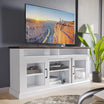






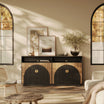
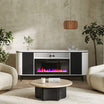
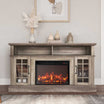
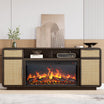
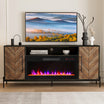
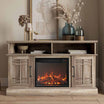
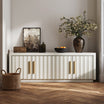
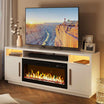
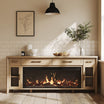
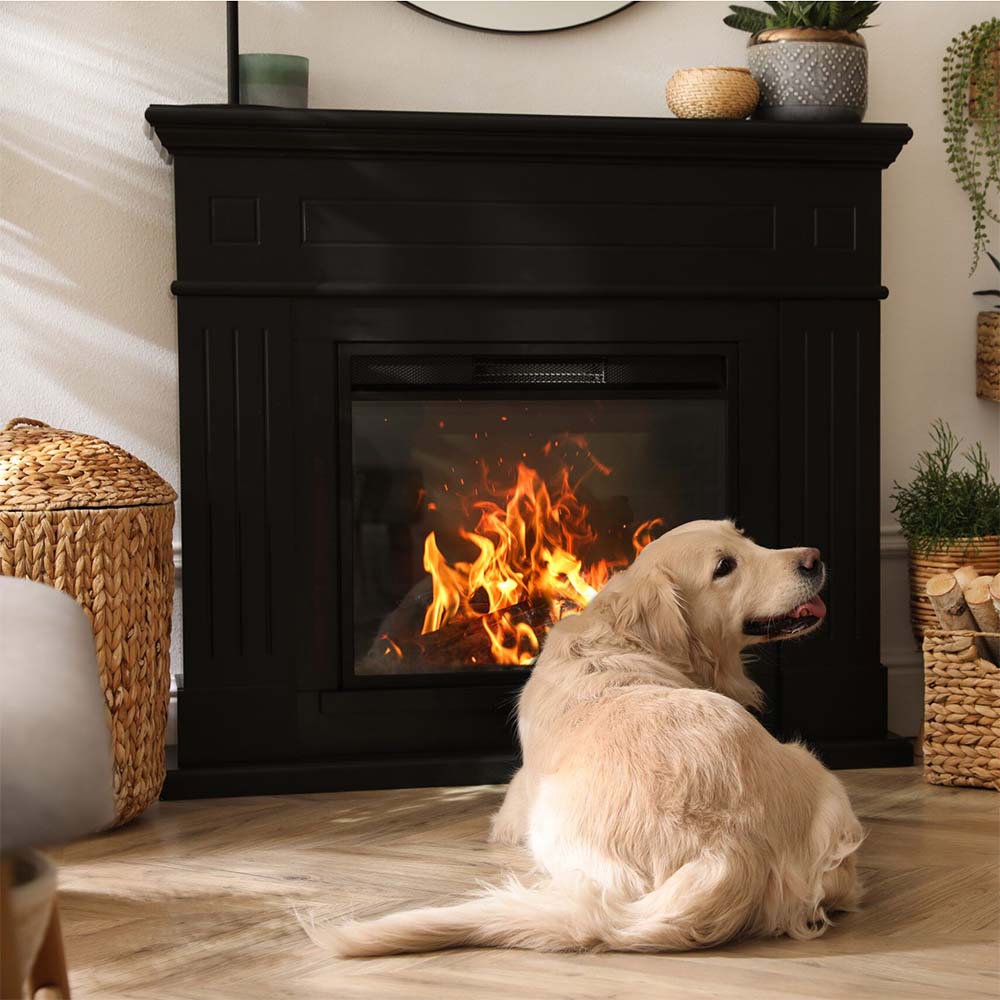


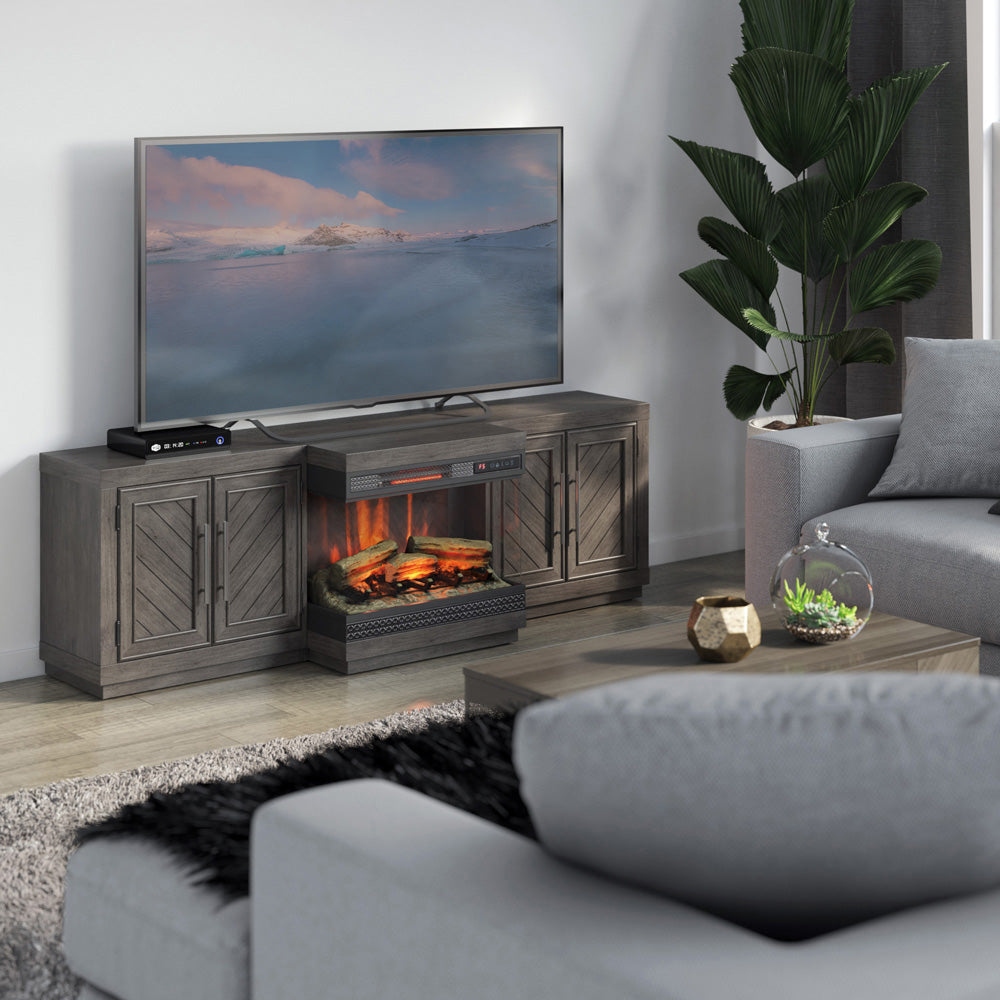

Leave a comment
This site is protected by hCaptcha and the hCaptcha Privacy Policy and Terms of Service apply.